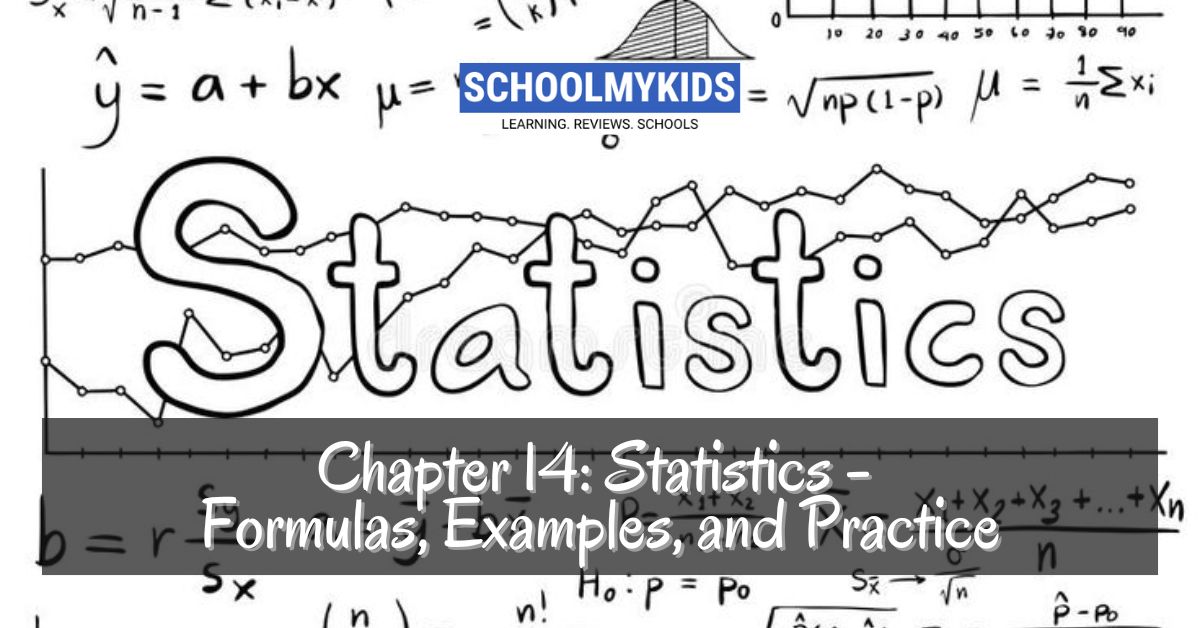This chapter dives into the world of statistics, exploring methods to organize, analyze, and interpret numerical data. Here, we’ll focus on measures of central tendency (average) and dispersion (spread) for grouped and ungrouped data.
Statistics helps us make sense of data. Here’s a breakdown of central tendency measures:
- Mean: The “average” of a set of values.
- Example: Your scores in 4 Maths tests are 75, 82, 90, and 88. Find the mean.
- Explanation: Mean = (75 + 82 + 90 + 88) / 4 = 83.75.
- Example: Your scores in 4 Maths tests are 75, 82, 90, and 88. Find the mean.
- Median: The “middle” value when data is arranged in order (ascending or descending).
- Example: Your project marks are 95, 87, 78, 92, and 100. Find the median.
- Explanation: Arrange the marks: 78, 87, 92, 95, 100. The median is 92.
- Example: Your project marks are 95, 87, 78, 92, and 100. Find the median.
- Mode: The value that appears most frequently.
- Example: You surveyed 10 friends about their favourite color. 4 chose blue, 3 chose red, and the others chose different colors. Find the mode.
- Explanation: Blue appears most often (4 times), so it’s the mode.
- Example: You surveyed 10 friends about their favourite color. 4 chose blue, 3 chose red, and the others chose different colors. Find the mode.
Formulas:
Central Tendency:
- Mean (Average) for Ungrouped Data: Σx₁ / n (Σ = sum, x₁ = individual values, n = total number of values)
- Mean (Average) for Grouped Data (Direct Method): Σfx / Σf (Σ = sum, f = frequency of each value, x = value of the class, Σf = total frequency)
- Median: The middlemost value when data is arranged in ascending or descending order. If there are two middle values, the median is the average of those two values.
- Mode: The value that appears most frequently in the data set.
Dispersion:
- Range: Difference between the largest and smallest values (maximum value – minimum value).
- Variance: Σ(x₁ – x̅)² / n (Σ = sum, x₁ = individual values, x̅ = mean, n = total number of values) (More commonly used for populations)
- Standard Deviation (SD): √(Σ(x₁ – x̅)² / n) (Square root of variance)
Note: Σ (sigma) represents summation; it means adding up the values for all data points.
Examples:
1. Mean, Median, and Mode (Ungrouped Data):
Calculate the mean, median, and mode for the following exam scores: 78, 82, 90, 85, 78, 88, 90
- Mean: (78 + 82 + 90 + 85 + 78 + 88 + 90) / 7 = 83.71
- Median: Order the data: 78, 78, 82, 85, 88, 90, 90. The median is the average of the two middle values (85 + 88) / 2 = 86.5.
- Mode: Both 78 and 90 appear twice, making them the joint modes.
2. Mean and Range (Grouped Data):
The following table shows the points scored by 20 students in a game:
| Points | Frequency |
| 10-15 | 3 |
| 16-20 | 5 |
| 21-25 | 7 |
| 26-30 | 5 |
- Mean (Direct Method): Σfx / Σf = [(12.5 * 3) + (18 * 5) + (23 * 7) + (28 * 5)] / 20 ≈ 21.75 points (calculated assuming the midpoint of each class represents the value)
- Range: Maximum value (28) – Minimum value (10) = 18 points
3. Variance and Standard Deviation (Ungrouped Data):
Find the variance and standard deviation for the weights (in kg) of 5 athletes: 65, 72, 78, 81, 85.
- Mean: (65 + 72 + 78 + 81 + 85) / 5 = 76.2 kg
- Variance: Calculate the squared deviations from the mean for each data point, sum them, and divide by the number of values (n = 5).
- Standard Deviation: SD = √(Variance) = √(Calculated Variance value)
Advanced Topics
- Quartiles: Divide the data into four equal parts. The first quartile (Q1) is the median of the lower half, the second quartile (Q2) is the median (already defined), and the third quartile (Q3) is the median of the upper half.
- Interquartile Range (IQR): Q3 – Q1 (represents the spread of the middle 50% of the data).
- Boxplots: Visual representations of data distribution using quartiles, IQR, and outliers.
- Measures of Skewness: How symmetrical the data distribution is around the mean.
- Measures of Kurtosis: How peaked or flat the data distribution is compared to a normal distribution.
Practice Questions (Continued)
- A survey collected the travel time (in minutes) for 10 commuters: 30, 42, 25, 38, 35, 40, 22, 33, 39, 31.
(a) Calculate the mean, median, and mode for the travel times. (b) Find the range and standard deviation of the travel times.
- The following table shows the daily newspaper reading hours for a sample of 25 people:
| Reading Hours | Frequency |
| Less than 0.5 | 5 |
| 0.5 – 1.0 | 8 |
| 1.0 – 1.5 | 7 |
| More than 1.5 | 5 |
(a) Calculate the mean reading time using the direct method. (b) Determine the range of reading times.
- A company recorded the weights (in kg) of 12 employees: 58, 62, 70, 75, 78, 81, 82, 85, 88, 90, 92, 95.
(a) Find the first and third quartiles (Q1 and Q3) for the employee weights. (b) Calculate the interquartile range (IQR).
Previous Year Questions (Examples):
- A research group recorded the following test scores for a statistics exam: 72, 85, 68, 90, 82, 78, 88, 95, 80, 75.
(a) Organize the data in ascending or descending order. (b) Determine the median and mode of the test scores.
- The hourly wages (in dollars) for a group of part-time workers are given below: 10, 12, 15, 10, 11, 18, 12, 14, 16, 15.
(a) Calculate the mean and range of the hourly wages. (b) Construct a frequency table for the data. (You can create a simple table with wage intervals and corresponding frequencies)
This chapter provided a foundation for understanding and analyzing numerical data. We explored measures of central tendency (mean, median, mode) that indicate the “average” value, and measures of dispersion (range, variance, standard deviation) that describe the “spread” of data points.
Short Notes
- Statistics deals with collecting, organizing, analyzing, and interpreting numerical data.
- Grouped data is organized into classes (intervals), while ungrouped data consists of individual values.
- The mean, median, and mode represent different aspects of the “center” of the data.
- Range, variance, and standard deviation quantify the spread or variability within the data set.
Examples:
- We calculated the mean, median, and mode for both grouped and ungrouped data sets.
- Examples demonstrated finding the range and standard deviation to understand the data spread.
Advanced Topics:
- Quartiles and the interquartile range (IQR) provide more detailed insights into data distribution.
- Measures of skewness and kurtosis delve deeper into the data’s shape and symmetry.
- Boxplots visually represent data distribution using quartiles and IQR.
Practice and Previous Year Questions:
Practice problems help solidify your understanding of statistical calculations.
- We included examples of calculating various statistics for different data sets.
- Previous year question examples provide a glimpse into the types of questions you might encounter on exams.
Conclusion
By mastering these statistical concepts, you can effectively analyze and interpret numerical data, drawing meaningful conclusions from various studies, surveys, and experiments. Remember, statistical analysis plays a crucial role in various fields, from research and business to social sciences and healthcare.









Be the first one to comment on this story.